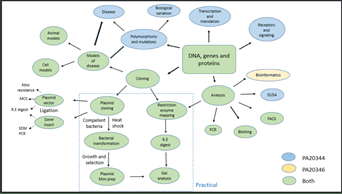Published on: 07/07/2023 · Last updated on: 03/09/2024
Top 10 approaches
As lecturers we can feel under immense pressure to cover the content of our discipline. Whilst there are a number of approaches we can employ to break up content and increase student engagement (e.g. individual activities, break out rooms, polls), there are also times when there is limited opportunity to do so. We can offset reduced interaction by ensuring the content itself is organised and arranged in a way which helps to maintain student focus, engagement and productivity.
The following approaches can be used to manage content at either course, unit, or session level. They also support students to develop their relational understanding (Skemp, 1989) so that they can make more explicit links between different concepts and ideas.
1. Use a Visual course/unit snapshot

Providing a visual course or unit snapshot can provide a useful road map for students to help them to ‘see’ the overall shape or arrangement of a subject. It can help students to visualise where they are heading and make important links between concepts and ideas. The following example was developed for Pharmacy and Pharmacology students to help them to better locate the practical work they were undertaking within the broader subject they were studying.
2. Prioritise knowledge
No matter how hard we try, students will not retain everything we teach them. What is important is that they retain the most important bits- the concepts, the underpinning frameworks, the key principles- the backbone knowledge on which they can then flesh out the detail. See if you can identify prioritised concepts, ideas, skills or key ‘take aways’ within (or across) your classes. Make these explicit to students. Which bits would you like them to remember years from now? Setting clear learning outcomes at the start can provide students with clear signposting for the session and help students to locate their learning within the overall course aims.
3. Move from concrete to abstract knowledge
Students are more likely to process and retain new ideas when we move them from concrete to abstract knowledge. Consider your students prior learning and build on this to help them to develop their understanding sequentially. Carefully chosen real- world examples and universal metaphors can also help students to apply, contextualise and transfer new ideas or concepts. When using examples or metaphors, keep these succinct and to the point; too much detail can detract from the point being made rather than reinforcing it.
4. Chunk knowledge
Bite-size chunks of knowledge are easier to digest and process, particularly when students are being introduced to a topic for the first time. See if your subject knowledge can be broken down into manageable chunks. Look at how the chunks relate to one another e.g. grouped under headings or using the Nested Knowledge approach outlined below to ensure that the chunks do not become too disconnected.
5. Make use of nested knowledge (the Russian doll approach)

We are more likely to retain new knowledge if we can link it or situate it within other knowledge (Bruner, 1963). A useful analogy to explain this is The Russian Doll Approach:
knowledge which is related to other knowledge, placed inside it rather like the parts of a Russian Doll, has the added bonus of being ‘sticky’. When ideas are nested we are more likely to ‘hold’ this new knowledge. (Enser, 2019)
To get a sense of how well your content is ‘nested’, print off a set of slides for one of your lectures. Focus specifically on the sequencing and try arranging your slides into a family tree rather than in the linear format of Powerpoint. Are there ideas or concepts which could be more explicitly nested inside another idea? Combining this approach with the Concept Map approach can help students to link and nest new ideas and concepts, which in turn boosts retention and understanding.
6. Dual code
Well-chosen images, diagrams or infographics can support working memory and help students to assimilate new ideas more effectively. This is known as dual coding and boosts our capacity to assimilate and retain new ideas (Paivio,1971). Dual coding can also help ensure our lecture slides or resources look distinct from one another which is also important for supporting information processing and working memory.
7. Is this a new idea or further detail?
A visual indicator on your slides can be used to highlight when you are moving on to a ‘new’ idea or drilling down into the detail and help students to organise this new content more systematically. This will also help students to maintain pace and reconnect to the material if they become disconnected or lost (both literally and figuratively).
8. Reinforce links
Rather than looking at the content itself, focus on the links that bind your subject together. Try to ‘remove’ your expertise and see how you would make the ‘jump’ from one idea to the next if you were seeing these ideas for the first time. The links you make will create and cement the shape of your subject, which will directly influence how a student makes sense of it. Signposting back to previous slides or forwards to future slides (either within or across sessions) can also really help to make links explicit
9. Build a narrative
One way of managing the sequencing of your content (either within a session or across a number of sessions) is to storyboard it, so you can visually map the learning journey for students. Storyboarding can help us take a step back from our content so we are not too close to it. Seeing it from a distance in this way can help us to think of the narrative we are building or the story we want to tell.
10. Audit your content using the four Rs
A content audit can be a useful way of reviewing lecture or unit content to ensure it is cohesive and aligns with the overall course design and accreditation. This can be done at course or unit level and works particularly well when designing with colleagues across a number of units. Use the following four Rs to review your content. For example, you may identify:
- content which can stay exactly as it is (Retain)
- content which is potentially repeated and could be merged or removed (Repetition)
- content which overlaps but provides a useful opportunity to consolidate knowledge (Reinforce)
- content which you would like to retain but could be recontextualised to better align with the course key concepts or ILOs as a whole (Recontextualise).
In addition to the four Rs, if you are updating your content, you may find it useful to identify if you have any gaps where new content needs to be added